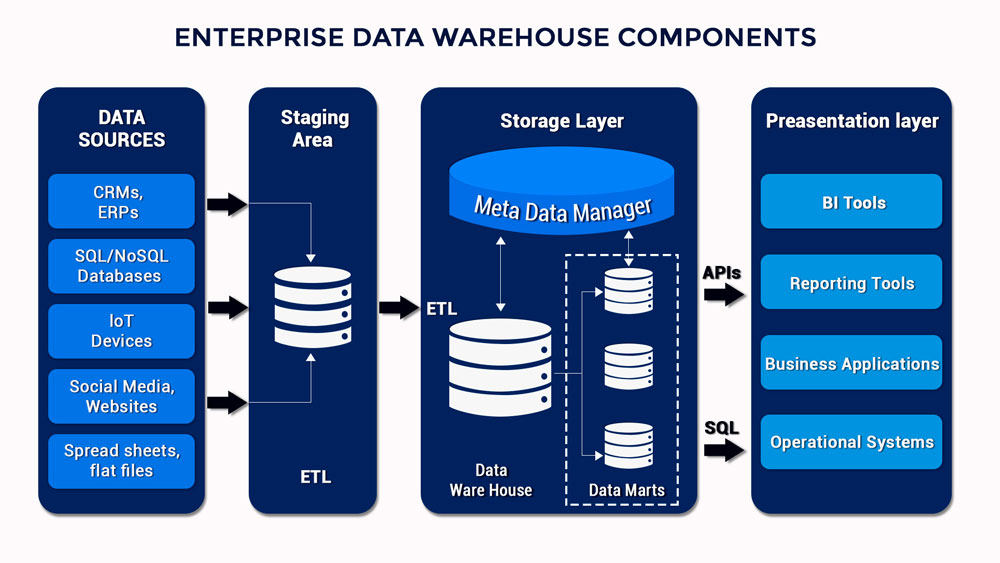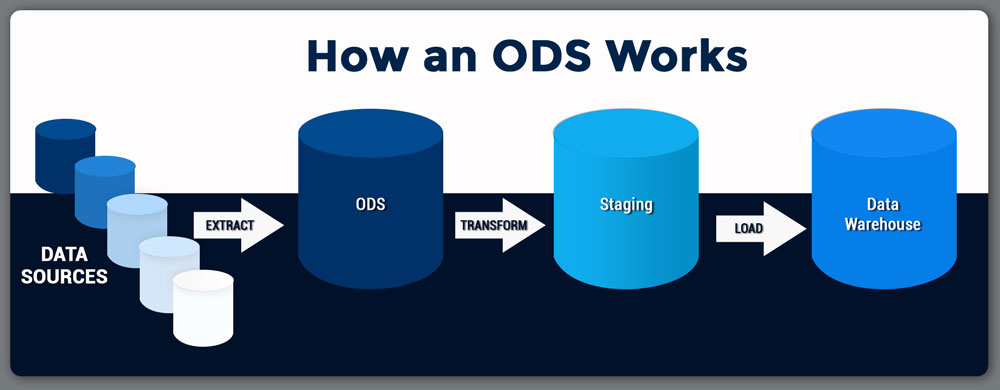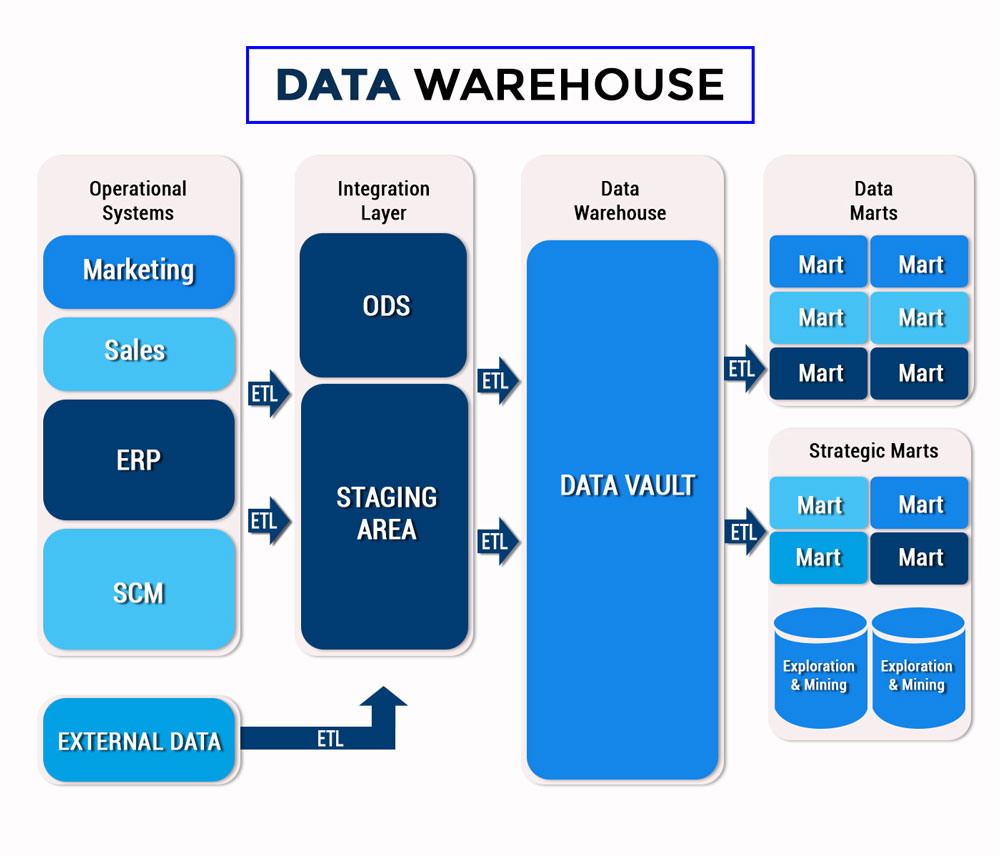
Data warehouse has been around for over two decades. It started as a means to transition raw data collection into information that businesses use to make critical decisions.
It’s no surprise that data warehouses are integral for businesses to scale and move forward. That said, there are several types of data warehouses that we can use.
But, before going in-depth on these, let’s first identify what this is at its core.
What Is a Data Warehouse: Database Vs Data Warehousing
Businesses use analytics to convert data into actionable insights. Among the most effective methods is the use of a data warehouse.
Think of it as a special-purpose database system specifically structured for analytics. The difference between a data warehouse and a database is where and how it gets or uses data.
Databases use OLTP (Online Transaction Processing) and are better at:
- Inserting data
- Replacing data
- Deleting data
- And, updating data.
Data Warehouse utilizes OLAP (Online Analytical Processing) to process and analyze massive amounts of data faster. This allows users to leverage the data warehouse for complex analytical queries on larger volumes of multi-dimensional information.
Warehouses collect data from several various sources such as marketing, sales, and finance. It also creates useful historical records for data scientists and business analysts that drive business intelligence activities.
Stages of Data Warehouse
There are four general components that make up a data warehouse. Each of these has its own function that helps data transition smoothly from one source to another. The four components are as follows:
- Load manager - The front component is the load manager. It handles data extraction and warehouse loading. These processes convert data for the data warehouse.
- Warehouse Manager - Analyzes data to guarantee consistency, creates indexes and views, generates denormalization and aggregations, and transforms and merges source data.
- Query Manager - The backend component is the query manager. It manages user inquiries. These data warehouse components schedule query execution by querying the right tables.
-
End-user access tools - There are five main categories to end-user access tools:
- Data query and reporting tools.
- Application development tools.
- Executive information systems (EIS) tools.
- Online analytical processing (OLAP) tools.
- Data mining tools.
Why Is a Data Warehouse Important?
Data warehouse allows organizations streamlined control of their collected data pulled from different sources. Because of this, they gain consistent cross-functionality across different platforms.
As a result, turnaround times for data analytics are greatly reduced, helping decision-makers make critical choices faster with more confidence.
Here are some more benefits of data warehousing:
1. Enhances Conformity and Quality of Data
Your company generates organized, unstructured, social media, and sales campaign data. A data warehouse turns this data into useful information presented in streamlined formats. It also guarantees that data from multiple business divisions are of the same quality and standard, allowing for more efficient analytics.
2. Streamlines Business Processes
Processing multiple data sources is time-consuming for a business user or data scientist. But because of a data warehouse, data can now be accessed in one location. In addition, a data warehouse makes this data available in the right format, enhancing process efficiency.
3. Boosts Revenue
Data warehouses create more standardized and better-quality data, which leads to smarter business intelligence with better decisions, and creates a higher ROI across your firm.
4. Promotes Data Security
Advances in data warehouse security have boosted enterprise data security. "Slave read only" inhibits dangerous SQL code while encrypted columns safeguard personal data.
5. Provides Scalability
In the cloud era, "scalable" is king, and a data warehouse drives this scale. A top-notch data warehouse is scalable and facilitates company scalability. Modern data warehouses can handle more queries as the firm expands.
Types of Data Warehouse
There are three main types of data warehouses across all industries:
- Enterprise: Relational data warehouse containing business data.
- Operational Data Store: Stores and processes data in real-time.
- Data Mart: Subset of data warehouses focusing on a specific part of a business.
Here’s an in-depth look at each:
Enterprise Data Warehouse

Enterprise data warehouses (EDW) are examples of relational data warehouses where you can find a company’s business data. You can find data on the following:
- Supply chain management
- Sales
- Warehouse and inventory
- Product data and descriptions
- Customer information
- Staff
- Information from customer surveys and interactive content
It’s a centralized warehouse that supports decision-making, organizing data, and subject-based data classification.
Operational Data Store
ODS is data storage required when neither the Data warehouse nor OLTP systems fulfill reporting demands. ODS's data warehouse is in real-time. It's used for everyday tasks like keeping employee records.

Data Mart

Data Marts are a subset of data warehouses. These are subject-oriented databases that support enterprise data warehouses. Information stored in data marts is useful for businesses such as sales, finance, or marketing.
In addition, it’s not uncommon to see data marts requiring users to download CSV files and combine data into static models.
But this approach has several drawbacks as mistakes can happen often due to human error, it takes up unnecessary time, and it’s not scalable.
Fortunately, the solution to these issues is easy once you learn how to build a modern data stack.
Key Takeaways
Businesses that require the processing of large amounts of data need a data warehouse. It can provide strategic advantages through streamlined data analytics and reporting that help decision-makers move forward with confidence.
More importantly, data warehouses allow organizations to make critical metric-based decisions from inventory to sales levels. That said, here’s a rundown of key points:
- A data warehouse is a data management system that centralizes data from all sources.
- Organizations can scale faster as data warehouses streamline business processes.
- A data warehouse is more secure compared to typical databases like SQL.
- Businesses can see an increased quality and consistency of data.
- Data warehouse promotes insight into finance, sales, marketing, and more.


































